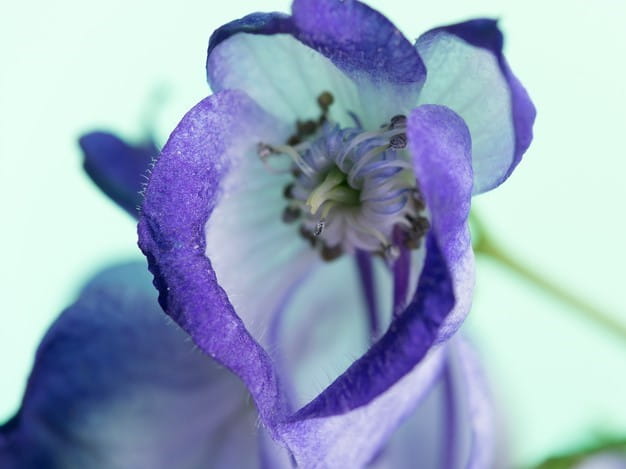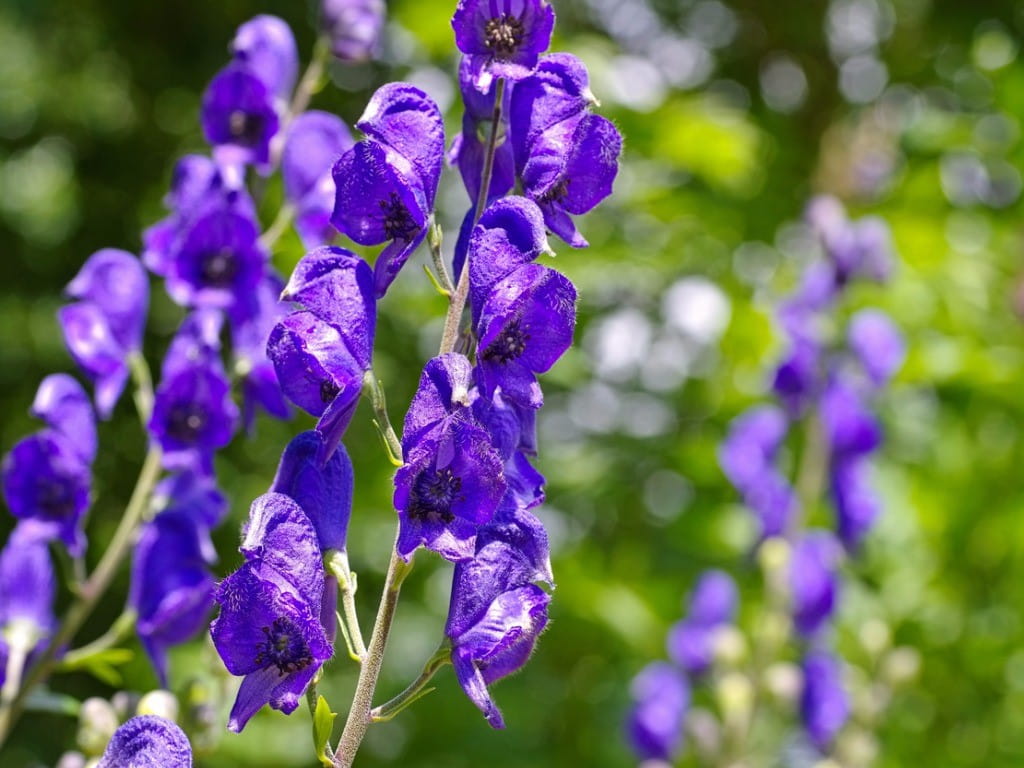Aconitum napellus (Monkshood): A Purple Poison

The Bottom Line
Aconitum napellus flowers look beautiful, but swallowing any part of the plant could be deadly.

The Full Story
Aconitum napellus (A. napellus, also known as monkshood or wolfsbane) is a perennial herb often grown as an ornamental plant due to its attractive blue to dark purple flowers. All parts of the plant, especially the roots, contain toxins. Aconitine is the most dangerous of these toxins. It is most noted as a heart poison but is also a potent nerve poison. Raw aconite plants are very poisonous.They are used as herbs only after processing by boiling or steaming to reduce their toxicity.
A. napellus has been used since ancient times as a poison used on spears and arrows for hunting and battle. As wolfsbane, it was believed to repel werewolves (and real wolves!). Ancient Romans used it as a method of execution.
A. napellus is native to western and central Europe where it is considered one of the most poisonous plants. Aconitine poisoning is rare in North America. When it does occur, it is generally due to confusion with an edible plant or unintentional ingestion by children. However, with the increasing popularity and availability of herbal medicines containing A. napellus, aconitine poisoning could occur more frequently.
Aconitine poisoning is most common in Asia due to the widespread use of herbal medications. In Hong Kong, aconitine is responsible for the majority of serious poisonings from Chinese herbal preparations. While the source of aconitine, especially in China, is usually Aconitum carmichaeli (chuanwu) or Aconitum kuznezoffii (caowu), the toxicity is similar to A. napellus.
Alleged therapeutic uses of A. napellus include treatment of joint and muscle pain. As a tincture applied to the skin, it is claimed to slow the heart rate in cardiac patients. Other claimed uses include reduction of fevers and cold symptoms.
In poisonings, the onset of symptoms occurs within minutes to a few hours after swallowing. The severity of aconitine poisoning is related to the rapid onset of life-threatening heart rhythm changes. Other symptoms can include numbness and tingling, slow or fast heart rate, and gastrointestinal manifestations such as nausea, vomiting, abdominal pain, and diarrhea. Respiratory paralysis and heart rhythm abnormalities can lead to death. The treatment is symptomatic and supportive; there is no specific antidote.
There is a very low margin of safety between therapeutic and toxic doses of aconitine. For example, a 66-year-old woman with no known heart disease obtained some from an herbalist. She was instructed to make a tea with it to treat her osteoarthritis. About 90 minutes after drinking the tea she developed numbness of her face, arms, and legs. This was rapidly followed by nausea, weakness, and chest pressure. In an ER, she was found to have an abnormal heart rhythm. After 4 hours of treatment with drugs and electrical shocks to her heart, a normal heart rhythm was restored.
There are cases of poisoning in which people intentionally swallow A. napellus they grow for themselves because of its claimed therapeutic effects. A 21-year-old man acquired Aconitum napellus plants after reading a book on herbal medicine. He ground up the roots of the plants and filled capsules with the dried material. He then took 1 capsule daily for several months to treat his anxiety. In order to increase the effects one evening, he swallowed 3 capsules and went to sleep. Five hours later he awoke with generalized numbness, nausea, diarrhea, dizziness, chest pain, shortness of breath, and defective color vision (he was seeing purple). It was believed that early symptoms went unnoticed because he was asleep. In an ER, his heart rate was very slow at 43 beats per minute, and he had an abnormal heart rhythm. Plasma concentrations of aconitine supported poisoning by A. napellus. He spent 48 days in the hospital.
If you think someone has swallowed Acotinum napellus, do not make the person vomit. Immediately check the webPOISONCONTROL® online tool for guidance or call Poison Control at 1-800-222-1222. Also, check our list of selected poisonous and non-poisonous plants to learn more.
Mary Elizabeth May, RN, BA, MPH
Certified Specialist in Poison Information
Poisoned?
Call 1-800-222-1222 or
Prevention Tips
- Let your healthcare provider know about all medications you are taking, including herbals.
- Never eat any plant found in a wilderness setting.
- Keep all plants out of the reach of children.
This Really Happened
Case 1. An 81-year-old couple was brought to an ER. They had both eaten a salad containing what they thought was ground elder from their private garden. The plant was later identified as Aconitum napellus. The man arrived at the ER in cardiorespiratory arrest but was successfully resuscitated.
The woman was conscious and told the staff what they had recently eaten. After eating the salad, they both had tingling and burning of their fingers and toes, then nausea, abdominal pain, dry mouth/hoarseness, and general numbness. About 30 minutes after eating the salad, the woman had severe vomiting and her husband collapsed, so she called 911. Her blood pressure was low and her heart rate was very elevated at 200 beats per minute. She was treated with drugs for her heart rhythm and recovered uneventfully.
Case 2. A man in his 50s was found dead behind the steering wheel of his car, which was in a ditch 60 miles from his home. The autopsy found trauma to several parts of his body, but it did not appear that he had died due to a car crash. He had an elevated blood alcohol concentration, but no other drugs or toxins were initially found.
Five years later, his wife confessed to killing him. She had boiled Aconitum napellus leaves and stalks. She mixed this with a few tablets of triazolam (used for insomnia) in a bottle of red wine. Her husband drank the wine at dinner. She found her husband lifeless 3-4 hours later. She put the body in the driver’s seat of their car. Sitting on the lap of the body, she drove the 60 miles, pushed the car into the ditch, and attempted to burn the car (she took a taxi home).
Close collaboration between the police and forensic pathologists and toxicologists helped to solve this case. Elaborate toxicological testing 5 years after the death found aconitine in the man’s urine, liver, and kidneys.
Case 3. A 25-year-old man in good health took an afternoon walk with friends on an uninhabited island off the coast of Newfoundland, Canada. He ate some wildflowers with purple and pink petals along with some blackberries at 2:30 PM. The flowers were later identified as A. napellus. At 5:00 PM he had nausea and abdominal pain and then vomited. He suddenly collapsed at 6:15 PM; resuscitation attempts were unsuccessful. Lab testing of his blood confirmed the presence of aconitine. The cause of death was declared aconitine poisoning due to ingestion of A. napellus.For More Information
Aconitum napellus, monkshood [internet video]. The Poison Garden [accessed Nov 6, 2017].
References
Poisoned?
Call 1-800-222-1222 or
Prevention Tips
- Let your healthcare provider know about all medications you are taking, including herbals.
- Never eat any plant found in a wilderness setting.
- Keep all plants out of the reach of children.
This Really Happened
Case 1. An 81-year-old couple was brought to an ER. They had both eaten a salad containing what they thought was ground elder from their private garden. The plant was later identified as Aconitum napellus. The man arrived at the ER in cardiorespiratory arrest but was successfully resuscitated.
The woman was conscious and told the staff what they had recently eaten. After eating the salad, they both had tingling and burning of their fingers and toes, then nausea, abdominal pain, dry mouth/hoarseness, and general numbness. About 30 minutes after eating the salad, the woman had severe vomiting and her husband collapsed, so she called 911. Her blood pressure was low and her heart rate was very elevated at 200 beats per minute. She was treated with drugs for her heart rhythm and recovered uneventfully.
Case 2. A man in his 50s was found dead behind the steering wheel of his car, which was in a ditch 60 miles from his home. The autopsy found trauma to several parts of his body, but it did not appear that he had died due to a car crash. He had an elevated blood alcohol concentration, but no other drugs or toxins were initially found.
Five years later, his wife confessed to killing him. She had boiled Aconitum napellus leaves and stalks. She mixed this with a few tablets of triazolam (used for insomnia) in a bottle of red wine. Her husband drank the wine at dinner. She found her husband lifeless 3-4 hours later. She put the body in the driver’s seat of their car. Sitting on the lap of the body, she drove the 60 miles, pushed the car into the ditch, and attempted to burn the car (she took a taxi home).
Close collaboration between the police and forensic pathologists and toxicologists helped to solve this case. Elaborate toxicological testing 5 years after the death found aconitine in the man’s urine, liver, and kidneys.
Case 3. A 25-year-old man in good health took an afternoon walk with friends on an uninhabited island off the coast of Newfoundland, Canada. He ate some wildflowers with purple and pink petals along with some blackberries at 2:30 PM. The flowers were later identified as A. napellus. At 5:00 PM he had nausea and abdominal pain and then vomited. He suddenly collapsed at 6:15 PM; resuscitation attempts were unsuccessful. Lab testing of his blood confirmed the presence of aconitine. The cause of death was declared aconitine poisoning due to ingestion of A. napellus.